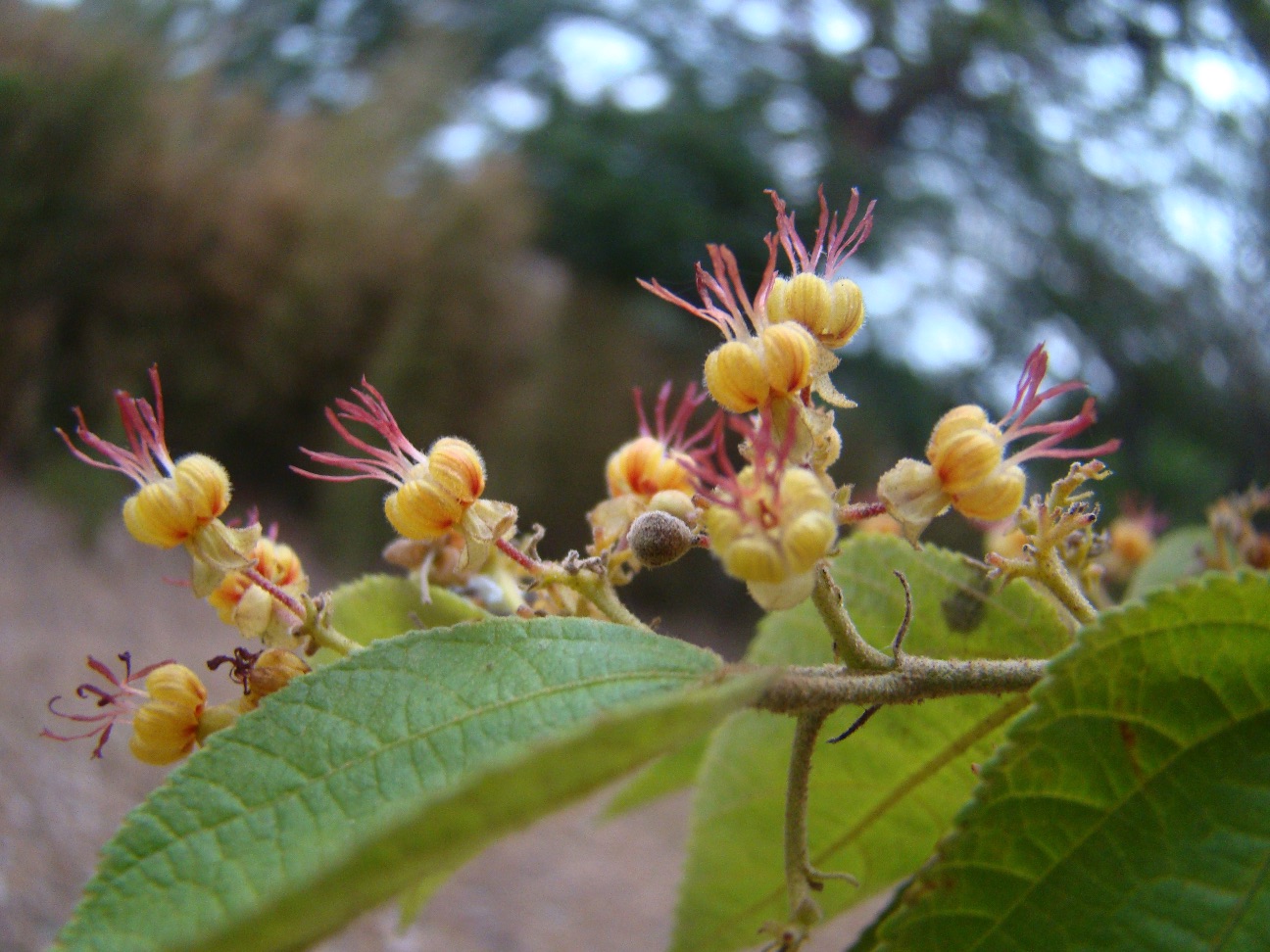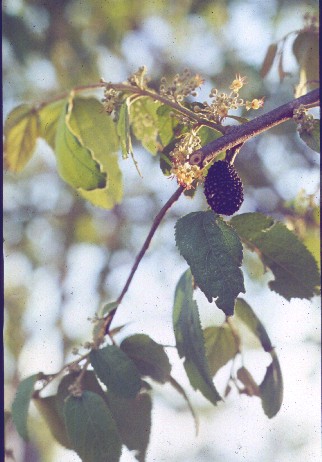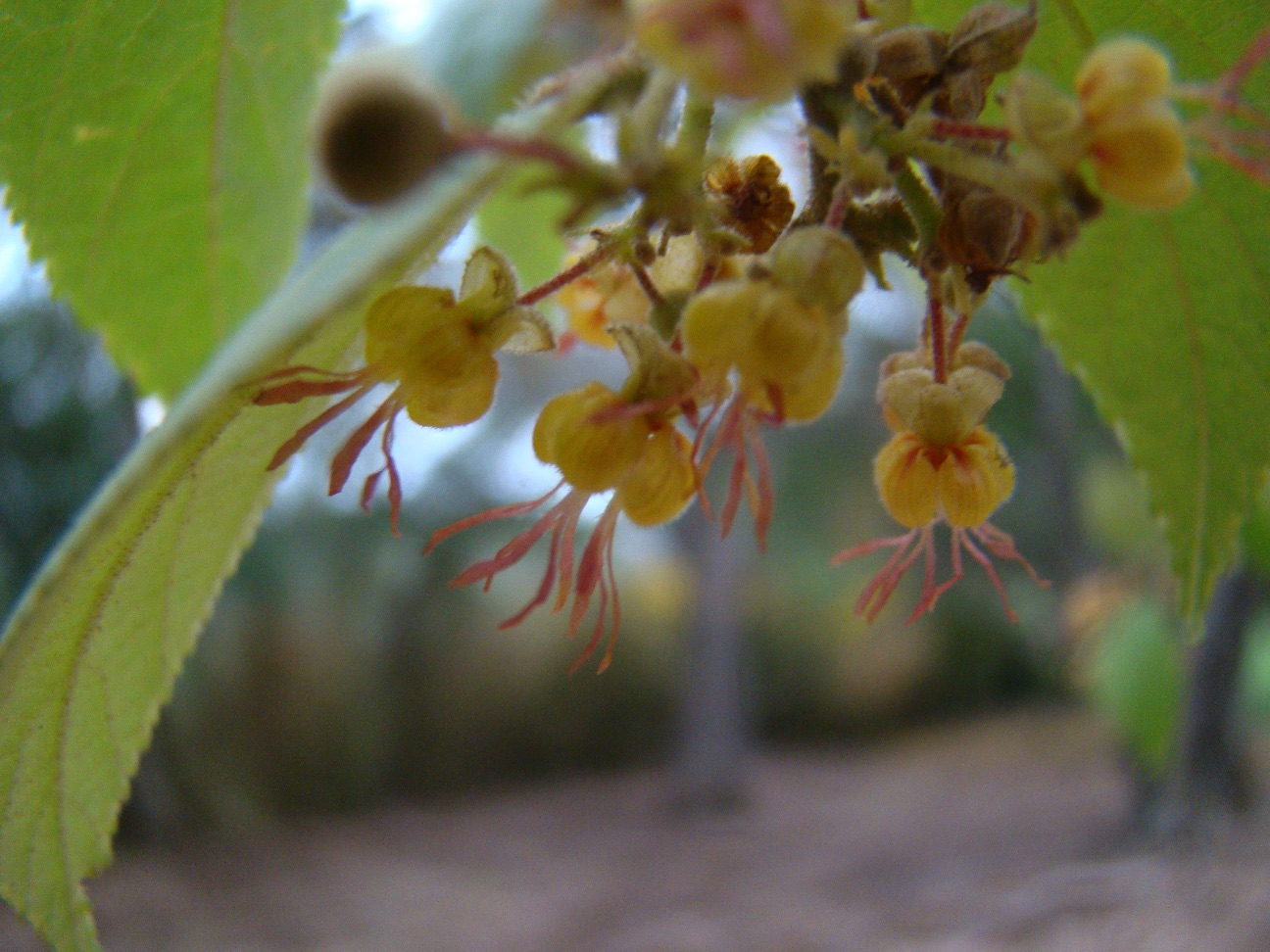Guazuma ulmifolia Lam.
Sterculiaceae
GUACIMO BLANCO
Common evergreen or briefly deciduous understory tree (5-15 m) associated almost exclusively with the young, secondary plant communities that flourish on disturbed sites. Guacimo blanco is one of Costa Rica’s most common and widespread arboreal species, being found in pastures and along roadsides all over the country. Persisting in the crown for many months, Guacimo’s black, woody, tubercle-laden fruits – highly prized by pasture animals – are a hallmark of the species.
Description: When found growing in open areas (e.g. pastures, roadsides) this tree often resembles a very large, overgrown shrub, with multiple, thin trunks (15 cm) and arching branches (or with a single, stouter bole, subdividing into branches less than a meter above the ground). Such specimens sport an abundant tangle of limbs covered with a thick layer of foliage, providing a dense, wide, and rounded crown. Forest specimens, corresponding more closely to the arboreal stereotype, generally exhibit single, unbranched boles of moderate thickness (35 cm) and stature, as well as narrow and open canopies. In all cases, the trunk is irregular, creased by shallow indentations or folds, and clad in roughly textured, light gray bark. Simple and alternate, Guacimo leaves are variable in size, averaging 12 cm in length by 6 cm in width. They have serrulate (finely serrate) margins, moderate drip-tips, and 1 cm petioles. Blades are of approximately lanceolate (spade) shape and have unequal, asymmetrical bases. Velvety in texture, leaf surfaces, veins, petioles, and young twigs are all cloaked in a thin layer of yellowish pubescence. Leaf senescence and loss begin in December and continue, at a slow pace, through March. Though new sprouts appear on the twigs almost immediately, they grow very slowly during the early dry season, leaving the trees largely bare for at least a portion of these months. Anticipating the return of wet conditions, Guacimo trees resume active growth in March, establishing a full and fresh leaf cover by late April.
Flowers appear as soon as the new shoots do, from leaf axils and arranged in compact cymes. The globular, green buds open into small (0.5 cm), pale yellow flowers with brown highlights. Each contains three sepals, five petals, five forward-projecting staminoid appendages, and five true stamens located inside the corolla. Flowering activity is maintained at a low level until March, when the increased rate of foliage growth results in a prolific burst of flower production that lasts through April.
Fruits are first seen amid the branches in June – at this time just small (3 mm), green orbs fastened to the twigs by short pedestals. Growing slowly over the next several months, they finally reach their full size of 3 cm long by 2 cm in diameter. Each fruit is a woody, ellipsoid capsule covered with stubby knobs and divided into six longitudinal compartments containing numerous, small (3 mm), angular black seeds. When broken, they emit a pleasant, sweet, cinnamon-like fragrance. Harvests begin slowly in December as the green fruits turn black and slowly fall from the trees. This process continues at a snails pace through April, when all of the fruits have finally become dislodged.
Family: The Sterculiaceae (700 sp.) is mainly a pantropical family of soft-wooded trees and shrubs, though it ranges into the subtropics as well. Most of its members share simple, alternate leaves with stipules; regular flowers with parts in fives, including small petals, stamens, and staminoid appendages; and fruits that are dry. Economically important Sterculiaceae species include the kola nut (Cola nitida) and cocoa (Theobroma cacao). Several other species have been used as ornamentals (Dombeya sp. – Africa, Pterospermum acerifolium – India) (Morley, 1978).
Similar Species: Goethalsia meiantha and, to a lesser extent, Apeiba tibourbou, are secondary forest trees whose foliage bare a superficial resemblance to that of Guacimo blanco. Still, Goethalsia and Apeiba lack the predominately shrubby growth habit of Guacimo and their leaves are significantly larger. In addition, Guacimo’s knobby, black fruits are unique and they are present (in some more or less developed condition) during 10 months of the year. Even when absent from the crown, these rot-resistant orbs can usually be located on the ground beneath the trees.
Natural History: Guacimo flowers are visited by insects. Currently, no animal species present in Manuel Antonio seems to be interested in Guacimo fruits, for they have been observed to accumulate beneath the parent trees and remain there until they slowly rot. Undoubtedly, Manuel Antonio’s now fragmented faunal population once included Spider monkeys – animals that still avidly eat these fruits in national parks like Santa Rosa.
During the months of May and June in Manuel Antonio, some species of insect – possibly a caterpillar – feeds aggressively on Guacimo foliage. Annually at this time, the newer leaves at the ends of the branches become fragmented and riddled with holes. After a few weeks, the predator apparently moves on to a different stage of its life cycle, because Guacimo leaves are then left alone. Foliage and twig growth nevertheless continue well into August, leaving the damaged leaves far back along the twig as persistent evidence of this predation.
Uses: Allen (1956) reports that Guacimo wood is pinkish, light, tough, and strong – but that it is not durable. It is supposed to make good charcoal and was used in Colonial times for the manufacture of gunpowder. The leaves and fruits of this species are eaten by cattle, and therefore Guacimo trees are purposefully left in pastures for the benefit of livestock. In addition, Guacimo sap has been used in sugar manufacture and its tough bark fibers can be used to produce twine or rope.
Distribution: In Manuel Antonio National Park (MANP), Guacimo is found along trail and road sides. It is especially abundant beside the ANEP and Lutz paths, in sites of secondary growth. It ranges from Mexico to Argentina and is also present in the Antilles.



